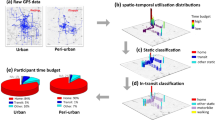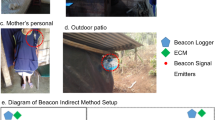Abstract
It has been shown that magnetic field exposure in apartments located directly on top or adjacent to transformer rooms is higher compared with exposure in apartments located further away from the transformer rooms. It is unclear whether this also translates into exposure contrast among individuals living in these apartments. We performed spot measurements of magnetic fields in 35 apartments in 14 apartment buildings with an in-built transformer and additionally performed 24-h personal measurements in a subsample of 24 individuals. Apartments placed directly on top of or adjacent to a transformer room had on average exposures of 0.42 μT, apartments on the second floor on top of a transformer room, or sharing a corner or edge with the transformer room had 0.11 μT, and apartments located further away from the transformer room had levels of 0.06 μT. Personal exposure levels were approximately a factor 2 lower compared with apartment averages, but still showed exposure contrasts, but only for those individuals who live in the apartments directly on top or adjacent to a transformer room compared with those living further away, with 0.23 versus 0.06 μT for personal exposure when indoors, respectively. A classification of individuals into ‘high’ and ‘low’ exposed based on the location of their apartment within a building with an in-built transformer is possible and could be applied in future epidemiological studies.
This is a preview of subscription content, access via your institution
Access options
Subscribe to this journal
Receive 6 print issues and online access
$259.00 per year
only $43.17 per issue
Buy this article
- Purchase on Springer Link
- Instant access to full article PDF
Prices may be subject to local taxes which are calculated during checkout
Similar content being viewed by others
References
Ahlbom A, Day N, Feychting M, Roman E, Skinner J, Dockerty J et al A pooled analysis of magnetic fields and childhood leukaemia. Br J Cancer 2000; 83 (5): 692.
Greenland S, Sheppard AR, Kaune WT, Poole C, Kelsh MA . A pooled analysis of magnetic fields, wire codes, and childhood leukemia. Epidemiology 2000; 11 (6): 624.
Kheifets L, Ahlbom A, Crespi C, Draper G, Hagihara J, Lowenthal R et al Pooled analysis of recent studies on magnetic fields and childhood leukaemia. Br J Cancer 2010; 103 (7): 1128–1135.
Mezei G, Kheifets L . Selection bias and its implications for case–control studies: a case study of magnetic field exposure and childhood leukaemia. Int J Epidemiol 2006; 35 (2): 397.
Schüz J . Exposure to extremely low-frequency magnetic fields and the risk of childhood cancer: Update of the epidemiological evidence. Prog Biophys Mol Biol 2011; 107 (3): 339–342.
Kheifets L, Oksuzyan S . Exposure assessment and other challenges in non-ionizing radiation studies of childhood leukaemia. Radiat Prot Dosimetry 2008; 132 (2): 139.
Ilonen K, Markkanen A, Mezei G, Juutilainen J . Indoor transformer stations as predictors of residential ELF magnetic field exposure. Bioelectromagnetics 2008; 29 (3): 213–218.
Röösli M, Jenni D, Kheifets L, Mezei G . Extremely low frequency magnetic field measurements in buildings with transformer stations in Switzerland. Sci Total Environ 2011; 409 (18): 3364–3369.
Hareuveny R, Kandel S, Yitzhak NM, Kheifets L, Mezei G . Exposure to 50 Hz magnetic fields in apartment buildings with indoor transformer stations in Israel. J Expo Sci Environ Epidemiol 2010; 21 (4): 365–371.
Thuróczy G, Jánossy G, Nagy N, Bakos J, Szabó J, Mezei G . Exposure to 50 Hz magnetic field in apartment buildings with built-in transformer stations in Hungary. Radiat Prot Dosimetry 2008; 131 (4): 469.
Feychting M, Kaune WT, Savitz DA, Ahlbom A . Estimating exposure in studies of residential magnetic fields and cancer: importance of short-term variability, time interval between diagnosis and measurement, and distance to power line. Epidemiology 1996, 220–224.
Forssén UM, Ahlbom A, Feychting M . Relative contribution of residential and occupational magnetic field exposure over twenty-four hours among people living close to and far from a power line. Bioelectromagnetics 2002; 23 (3): 239–244.
Skotte JH . Exposure to power-frequency electromagnetic fields in Denmark. Scand J Work Environ Health 1994; 20 (2): 132–138.
EPRI. TransExpo: International Study of Childhood Leukemia and Residences Near Electrical Transformer Rooms, Protocol 2010. http://my.epri.com/portal/server.pt?Abstract_id=000000000001019901 EPRI; 2010. Report No. 1019901.
Brasche S, Bischof W . Daily time spent indoors in German homes--baseline data for the assessment of indoor exposure of German occupants. Int J Hyg Environ Health 2005; 208 (4): 247–253.
Roy M, Courtay C . Daily activities and breathing parameters for use in respiratory tract dosimetry. Radiat Prot Dosimetry 1991; 35 (3): 179–186.
Neubauer G, Feychting M, Hamnerius Y, Kheifets L, Kuster N, Ruiz I et al Feasibility of future epidemiological studies on possible health effects of mobile phone base stations. Bioelectromagnetics 2007; 28 (3): 224–230.
Maslanyj M, Simpson J, Roman E, Schüz J . Power frequency magnetic fields and risk of childhood leukaemia: misclassification of exposure from the use of the ‘distance from power line’exposure surrogate. Bioelectromagnetics 2009; 30 (3): 183–188.
Szabó J, Jánossy G, Thuróczy G . Survey of residential 50 Hz EMF exposure from transformer stations. Bioelectromagnetics 2007; 28 (1): 48–52.
Wertheimer N, Leeper E . Electrical wiring configurations and childhood cancer. Am J Epidemiol 1979; 109 (3): 273.
Green LM, Miller AB, Agnew DA, Greenberg ML, Li J, Villeneuve PJ et al Childhood leukemia and personal monitoring of residential exposures to electric and magnetic fields in Ontario, Canada. Cancer Causes Control 1999; 10 (3): 233–243.
Kheifets LI, Kavet R, Sussman SS . Wire codes, magnetic fields, and childhood cancer. Bioelectromagnetics 1997; 18 (2): 99–110.
Tarone RE, Kaune WT, Linet MS, Hatch EE, Kleinerman RA, Robison LL et al Residential wire codes: reproducibility and relation with measured magnetic fields. Occup Environ Med 1998; 55 (5): 333.
Ger WJ, Chang WP, Sung FC, Li YL . Accuracy of short-term residential measurement in the prediction of 72-h exposure to power frequency magnetic field in households very close to high-tension transmission lines. J Expo Sci Environ Epidemiol 2006; 17 (1): 69–75.
Levallois P, Gauvin D, Gingras S, St-Laurent J . Comparison between personal exposure to 60 Hz magnetic fields and stationary home measurements for people living near and away from a 735 kV power line. Bioelectromagnetics 1999; 20 (6): 331–337.
Juutilainen J, Hatfield T, Läärä E . Evaluating alternative exposure indices in epidemiologic studies on extremely low-frequency magnetic fields. Bioelectromagnetics 1996; 17 (2): 138–143.
Kavet R, Silva JM, Thornton D . Magnetic field exposure assessment for adult residents of Maine who live near and far away from overhead transmission lines. Bioelectromagnetics 1992; 13 (1): 35–55.
Friedman DR, Hatch EE, Tarone R, Kaune WT, Kleinerman RA, Wacholder S et al Childhood exposure to magnetic fields: residential area measurements compared to personal dosimetry. Epidemiology 1996, 151–155.
McBride M, Gallagher R, Theriault G, Armstrong B, Tamaro S, Spinelli J et al Power-frequency electric and magnetic fields and risk of childhood leukemia in Canada. Am J Epidemiol 1999; 149 (9): 831.
Acknowledgements
This work was supported by The Netherlands Organization for Health Research (ZonMW) within the program Electromagnetic Fields and Health Research under grant numbers 85500006 and 85800001, and performed in collaboration with the international TransExpo study group. We thank Gabor Mezei and Leeka Kheifets for input and for providing us with the measurement protocol of the TransExpo study. We also thank Mathieu Pruppers and Gert Kelfkens from the National Institute for Public Health and the Environment (RIVM) for help with setting up the study. We are especially grateful to the electricity companies for their helpful assistance in giving us access to transformer rooms for measurements, and for performing the load measurements of the transformers.
Author information
Authors and Affiliations
Corresponding author
Ethics declarations
Competing interests
The authors declare no conflict of interest.
Additional information
Supplementary Information accompanies the paper on this Journal of Exposure Science and Environmental Epidemiology website
Supplementary information
Rights and permissions
About this article
Cite this article
Huss, A., Goris, K., Vermeulen, R. et al. Does apartment’s distance to an in-built transformer room predict magnetic field exposure levels?. J Expo Sci Environ Epidemiol 23, 554–558 (2013). https://doi.org/10.1038/jes.2012.130
Received:
Revised:
Accepted:
Published:
Issue Date:
DOI: https://doi.org/10.1038/jes.2012.130
Keywords
This article is cited by
-
Exposure levels of ELF magnetic fields in the residential areas of Mangaung Metropolitan Municipality
Environmental Monitoring and Assessment (2018)
-
Analysis of personal and bedroom exposure to ELF-MFs in children in Italy and Switzerland
Journal of Exposure Science & Environmental Epidemiology (2016)
-
Indoor transformer stations and ELF magnetic field exposure: use of transformer structural characteristics to improve exposure assessment
Journal of Exposure Science & Environmental Epidemiology (2014)



